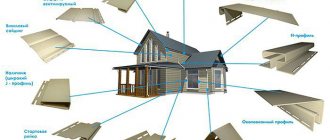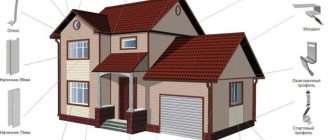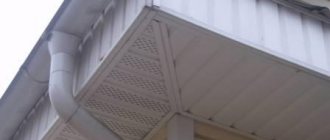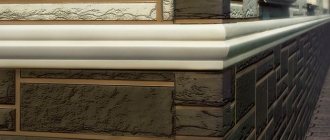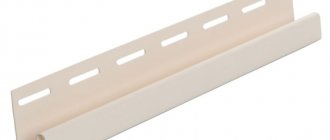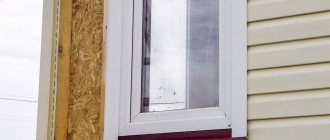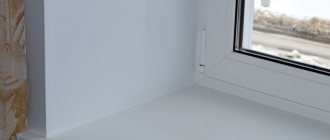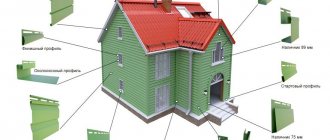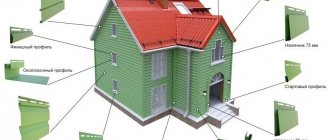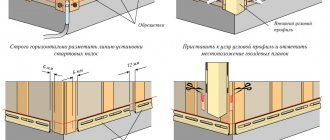Vinyl siding is a modern type of finishing material used to decorate facades. With its help you can give a neat and original appearance to any structure. The material is quite easy to install, but it will not be possible to simply nail it to the walls of the house. To do this, you will need additional elements for vinyl siding, the sizes of which differ depending on the manufacturer of the finishing material.
Additional elements for vinyl siding: dimensions
H-profiles for siding
Features of vinyl siding
The production of vinyl siding began in the late 50s of the twentieth century. Externally, it is no different from facade boards, but its main advantage is durability. It will not lose its appearance for decades. It is not afraid of temperature changes, it is not afraid of showers, winds and snow, so it can be used in almost any climatic conditions.
Vinyl siding
On a note! High-quality vinyl siding does not fade for more than 10 years. During this time, it is quite possible to have time to build several extensions, but at the same time they will not differ from each other in color. Of course, we are not talking about low-quality material.
Dimensions and thickness of vinyl siding
Rules for installing ordinary siding panels
Vinyl siding is produced by the extrusion method, when raw materials are pressed through special holes, resulting in long vinyl strips of certain parameters. The resulting tape is cut and shaped, giving it a working profile.
Vinyl siding production
Moreover, in most cases, siding is now produced using the so-called co-extrusion method, when the siding panel is made of two layers, with the layers being connected to each other at the molecular level. The main outer layer makes up approximately 20-25% of the total thickness of the panel and protects the finishing element itself from the negative effects of natural factors such as precipitation and ultraviolet radiation. And the inner layer holds the shape of the product and is necessary for the panel to be durable and frost-resistant.
Vinyl siding contains the following substances.
- PVC or polyvinyl chloride. In percentage terms, this substance is precisely the main one - its share in each siding panel is about 80% of the total mass of the product. The strength and quality of the siding itself will depend on the quality of this material. Unscrupulous manufacturers trying to save money at the siding production stage may add less PVC to the raw material than necessary (only 70%). This significantly affects the quality of the material. Siding may also contain recycled materials.
Siding for a blockhouse
- Calcium carbonate. Mass fraction – no more than 15%. The substance is necessary to fill the structure of the siding sheet.
- Titanium dioxide It is a component of the top layer (up to 10%). Thanks to this additive, the siding is protected from ultraviolet radiation and retains its color well and does not fade longer.
- Butadiene. Necessary to stabilize the structure of the material. Mass fraction – up to 1%.
- Paint is necessary to give the siding a specific color.
- Modifiers are used to protect the material from mechanical damage.
Vinyl siding is divided into several types, each of which has its own purpose.
Vinyl siding has become one of the most popular for good reason. It still has a lot of advantages, in addition to those listed above. These are durability, ease of maintenance, fire safety and excellent resistance to chemicals.
However, in order to cover the facade with vinyl siding, it is not enough to buy the panels themselves - you will also need additional elements. Which, by the way, also perform an aesthetic function.
Vinyl siding
Vinyl siding prices
Vinyl siding
Why are additional elements needed?
Additional parts for installing siding panels are used to achieve several purposes. This facilitates the installation process, gives a finished look to the facade of the building, and secures the panels to the walls of the house. Thanks to them, the entire finish will hold as firmly as possible and last longer - due to corner additions, for example, it is possible to achieve greater tightness of the entire cladding, which means that moisture and wind will have less impact on the main walls of the building. If you use special parts for installing siding, then the finished structure will not rattle during the violence of the elements on the street, which is especially important for windy regions.
Additional siding elements
On a note! If you refuse to use additional elements when covering the facade of a house with siding, then you will not be able to give a finished and beautiful look to the building. There will be cracks and gaps everywhere, and the structure will look sloppy.
All additional siding elements have special holes, which allow them to be tightly and securely joined to the siding panels. In this case, the perforation has an oblong shape, which makes it possible to take into account the temperature coefficient of expansion and helps to avoid deformation of the material under the influence of temperatures. In general, there should be no gaps or cracks between the installed panels and extensions.
Vinyl siding photo cladding
Attention! Any swelling of the panels is the first sign of improper installation of elements or low-quality finishing material.
Finishing a house with siding
Installation of corner profiles
Fastening of fittings occurs at a certain stage of finishing work and includes a number of mandatory actions.
Internal corner
You can attach it using the following algorithm:
This angle is also used when sheathing gable and roof overhangs.
External element
An external part of complex shape is most preferable for outside work. Installation is carried out according to the following scheme:
The outer corner segment is used for finishing window and door openings, acting as a platband.
You should know! Simple elements are attached on top of the created skin; for this purpose, holes are drilled in them.
Attaching a simple corner over siding
Types of siding additions
There are two types of additional parts used for siding installation. These are decorative or load-bearing elements. The former are used only for the decoration of the building, while the latter are necessary directly for the installation of the finishing panels themselves.
Finishing and mounting strips (additional elements) for siding
Elements that are necessary for installing siding.
- The J-profile is necessary for the design of vertical seams, doors and windows; the siding panels themselves will be inserted into it. It is also used to decorate soffits, the ends of pediments, and can be used to decorate corners, but the joint will not be closed as well as when using special corner elements.
- A starting strip or strip is necessary to begin the installation of siding panels. This is the main element, without which the facade cladding process cannot be started. The plank is installed either at the very bottom of the building or at the edge of the wall (depending on the cladding method - horizontal or vertical), and the panels themselves are attached to it.
- Corner elements are necessary to decorate the internal or external corners of a building. At the same time, separate types of add-ons are sold for both.
- H-profile is used to connect two siding panels if the sheathed facade is too long. The element also provides connection between soffit panels.
Vinyl siding trim strips
Special decorative elements required for siding installation.
- Finishing plank , thanks to which you can beautifully complete the decoration of walls with siding.
- Window trim and platband are used to decorate window and door openings if they are recessed into the wall.
- Gutters are necessary to drain water from the walls of a building during rain.
- Bevels for cornices are used to design slopes and cornices with a small width.
Additional elements of Grand Line® Amerika vinyl siding
On a note! The material used to make the additional elements is the same as the siding panels themselves. They differ from siding only in their structure, shape, and size.
Prices for additional elements of vinyl siding
Additional elements of vinyl siding
Video - Additional elements for siding
Installation of corner profiles
Fastening of fittings occurs at a certain stage of finishing work and includes a number of mandatory actions.
Internal corner
You can attach it using the following algorithm:
This angle is also used when sheathing gable and roof overhangs.
External element
An external part of complex shape is most preferable for outside work. Installation is carried out according to the following scheme:
The outer corner segment is used for finishing window and door openings, acting as a platband.
You should know! Simple elements are attached on top of the created skin; for this purpose, holes are drilled in them.
Why do you need to consider sizes?
All additional elements have their own sizes. They differ from each other in length, width, configuration. Moreover, differences are observed not only between different elements, but also between identical ones produced by different manufacturers.
On a note! Even from the same manufacturer, but in different lines, additional elements may differ in parameters. Moreover, there are no special standards that would regulate the size of siding and its components.
Vinyl siding installation
The length of one siding panel can vary from 2.5 to 4 m among different manufacturers, the width - from 20 to 30 cm. Even the thickness can vary from 1 to 1.2 mm. In the same way, the additions differ from each other by small but still noticeable amounts.
That is why it is so important to correctly take into account all the parameters of both the siding itself and its additional elements when calculating the amount of materials required for cladding the facade of the house. And you need to buy all the components from one selected manufacturer, so that later during the installation process there are no questions or inconsistencies. The dimensions of the extensions and siding panels must also fit together and fit together.
Vinyl siding "Alta-Profile"
Scaffolding prices
Scaffolding
Dimensions of additional elements
Now let’s take a closer look at the sizes of siding components from different manufacturers. The following products are especially popular (VOX), Grand Line and Döcke.
Siding Döcke (made in Germany)
The VOX company produces vinyl siding, ideal for decorating the facades of residential buildings and office buildings. The products are distinguished by their durability and quality. Simplicity of installation allows you to cover the facade yourself, without resorting to the services of specialists.
Vinyl siding VOX
Vox siding is a Polish-made material that initially gained popularity throughout Europe and Turkey
Table. Dimensions of siding components from VOX.
| Name and image | Parameters, m |
Soffit | Panel length – 2.7, width – 0.3 |
Starting bar S-11 | Length – 3.81 |
External corner S-12 | Length – 3.05 |
Internal corner S-13 | Length – 3.05 |
J-profile S-15 | Length – 3.81 |
Connecting strip S-18 | Length – 3.05 |
Window strip S-17 | Length – 3.81 |
Window strip S-20 | Length – 3.81 |
Facade strip S-19 | Length – 3.81 |
Mounting bar S-16 | Length – 3.81 |
Finishing strip S-14 | Length – 3.81 |
Grand Line siding is a high-quality finishing material that has been present on the Russian market for more than 10 years. The company is one of the few that produces both metal and vinyl siding.
Vinyl siding Grand Line
Grand Line vinyl siding colors
Table. Dimensions of siding components from Grand Line.
| Name and image | Length, m |
| Starting bar | 3,6 |
External corner and internal corner | 3 |
| Connecting H-profile | 3 |
| Window strip | 3,05 |
| Wind board or J-bevel | 3 |
| J-profile and wide J-profile | 3/3,05 |
| Finish bar | 3,6 |
| Soffit | 3 |
Döcke siding is one of the best products of this type on the market. Siding panels and components for them are produced from high-quality raw materials.
Siding and additional elements "Doke"
Siding Docke Blockhaus
Vinyl Siding Docke
Table. Dimensions of siding components from Döcke.
| Name and image | Length, m |
Solid soffit | 3.05 or 1.85 (working width 0.305) |
Finish profile | 3,05 |
H-profile | 3,05 |
External corner | 3,05 |
Internal corner | 3,05 |
J-profile | 3,05 |
Slope | 3,66 |
Molding | 3,05 |
J-chamfer | 3,05 |
Low tide | 3,05 |
Start profile | 3,05 |
Edge profile | 3,05 |
Near-window profile | 3,66 |
Installing the launch pad
Insert the first panel into the start profile. Place the ends into the grooves of the corner elements. Make sure there are end clearances. We start fixing the panel from the middle, moving towards the edges. Don't forget about the gap under the screw head.
If the panel is shorter than the length of the wall, use a connecting strip - H-profile - for extension.
You can do without a plank; in this case, we install the siding with an overlap.
Tips for choosing
Selection of siding and components
In order for siding installation to be quick and easy, it is necessary to approach the selection of materials and components with all responsibility and attention.
- You should only choose materials from a trusted manufacturer, who has been on the finishing materials market for many years. If it is necessary to create extensions to the building, it will be much easier to purchase exactly the same siding as before. But a fly-by-night company may disappear from the market, and then you will have to work hard to find at least externally similar material and components.
- You only need to buy the additions and the siding itself from one company. This will avoid inconsistencies in the size of the finishing material, which will simplify installation and save nerves.
- It is best to buy elements specially designed for this purpose for finishing certain parts of the facade. Thus, it will be possible to achieve maximum protection of the walls of the house directly. Otherwise, cracks and gaps may form, although some additional elements are relatively interchangeable.
Facing with log siding
Using vinyl siding under a log
Finishing strip for siding
Siding is well suited for both an expensive country cottage and a simple country house. However, siding panels alone are not enough for finishing - you will also need other parts, which are called additional elements, including the finishing strip for the siding.
Calculation of additional elements
One of the main stages during preparation for covering the facade with siding is calculating the required number of additional elements. The following instructions will help you do it.
Step 1. You need to arm yourself with a tape measure, pencil, paper and calculator: all heights, lengths and widths, as well as window and door openings, corners of the house are measured. Then an exact diagram of the structure to be sheathed is drawn, indicating on it all the measured parameters with maximum accuracy.
Facing with log siding
Step 2. The first thing to consider is the amount of siding itself. To do this, the total area of each wall is calculated, and the area of the door and window openings is subtracted from the resulting value. Next, the resulting result is divided by the usable area of one siding strip.
Calculation example for siding panels
Important! When making calculations, be sure to take into account the amount of waste and buy finishing material with some reserve. This applies to both siding and additional elements. Waste is about 7-10%. With a complex structure configuration - up to 15%.
Step 3. Next, the number of starting and finishing stripes is calculated. The result is easy to obtain in linear meters - the length of all the walls of the house is measured, the resulting result is divided by the length of one plank.
Location of start and finish lanes
Step 4. The number of corner strips is calculated as follows: the number of internal and external corners is counted, and then each value is multiplied by the height of the corner. The final result is divided by the length of the corner strip.
Corner strips
Advice! It is better to count the number of planks separately for all corners, so that you do not have to make too many connections and assemble corner planks at one of the corners from pieces and trimmings. Such joints are very striking.
Step 5. J-profiles can be calculated by summing the lengths and widths of all horizontal and vertical sections, that is, the perimeters of door and window openings, wall ends, etc. The resulting figure is divided by the length of one plank.
J-profiles
Step 6. The H-profile is calculated if two siding strips are connected to each other in length. Here you have to count piece by piece.
H-profile
Step 7. The number of window strips is calculated individually (so that there are no joints that spoil the appearance), provided that one J-profile is not enough when installing siding. That is, if the door or window opening is recessed more than 20 cm into the wall of the house.
Window and door trims
Docking methods
In the case when you need to make one corner profile from 2 pieces, you should use one of the methods suggested below:
- Overlap. To do this, 2 separate pieces are first folded on a horizontal surface, as it should look on the wall. One part should be 2 cm over the other. This part is adjusted to the required size. Then you need to cut off the perforated edge in the area that you plan to attach first. Next, the structure is disassembled and begin to be fixed in parts, first the lower one, and then the upper one. This method most reliably protects the finish and base from precipitation and moisture.
- Docking using overlays. To do this, take a J-profile. It needs to be bent at an angle of 90°. To do this, the inner part of the profile is cut and given the desired shape. Then such an overlay is put on the lower and upper parts alternately. In this case, the overhead parts are fixed in the same way as the corner elements.
The method is not as practical as the previous one. The lining allows precipitation and even dust to pass through at angles, which provokes the development of destruction. Therefore, it is advisable to select dimensions that will coincide as much as possible with the height of the corner of the house.
